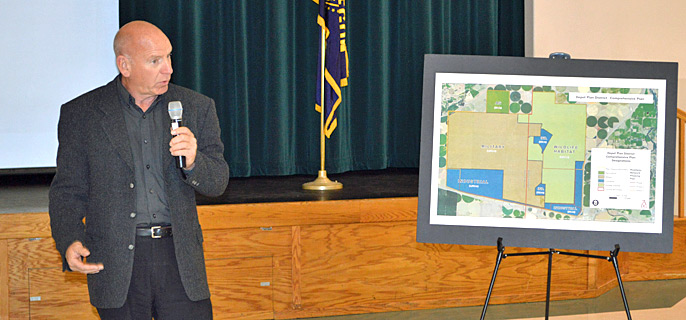
What do you do with 17,000 acres of land that for more than 70 years has been used to store conventional and chemical weapons and has never been given a zoning designation?
That question is currently being answered by the Umatilla Army Base Reuse Authority (UMADRA) in cooperation with local, state and federal agencies. At the Hermiston Chamber of Commerce’s Business to Business Luncheon on Tuesday, several representatives of those groups shed some light on how the Army is going to transfer the land so it can be used for both public and private purposes.
Don Chance, executive director of the Umatilla Army Depot Reuse Authority, said his group is dealing with two large bureaucracies – the United States Department of Defense and Oregon’s land-use planning process.
“It’s been complicated,” Chance said. “We’re dealing with 17,000 acres that have never been zoned. The state’s never faced a situation like this before.”
UMADRA is hoping to get the land transferred to them from the Department of Defense through an economic development conveyance. The first step in the process is to put together a re-development plan.
“You can imagine the politics have been kind of gnarly,” he said. “You’re dealing with a lot of entities.” Chance said there is a 1,200-page document that cost $800,000 to create that outlines all the federal requirements that UMADRA must comply with prior to the land transference.
Umatilla County Planning Director Tamra Mabbott said there will be formal land-use hearings in early 2014.
“It’s not easy in Oregon to say, ‘Hey, I want a couple thousand acres of industrial property out in an area that’s never been industrial before,’ but our state partners are on board so we’re hopeful that process will be a fairly smooth one,” Mabbott said.
About 7,500 acres of the depot land is designated for use by the Oregon National Guard as a training facility. Stan Hutchinson, chief of planning and programing for the Oregon Military Department, said a similar training site in Clatsop County generated about $14 million for the local economy in 2011.
“I would expect it to be very similar for this area,” he said.
Jim Lindseth of the U.S. Army said the site will feature a full-time infantry school for Army personnel from all over the United States. He expects about 3,000 personnel will be at the infantry school.
“You can imagine how that will impact the local economy,” he said.
Another 5,600 acres of depot land will be set aside as a wildlife refuge. Chance said those acres have been largely unaffected by the depot’s activities over the decades. He called it “fairly pristine” land that has some of the last remaining shrub steppe habitat in the state.
“The problem is, we can’t find a home for it,” Chance said. “Ideally, we’d like a local entity to take up the management of it.”
An additional 3,000 acres of depot land will be set aside for industrial zoning, which Mabbott said is the best use for the depot property. UMADRA is currently working with Umatilla and Morrow counties as well as the state on the zoning process. The land, however, has its share of liabilities, said Chance.
“There’s a large warehouse district with buildings built in the 1940s,” he said. “They have asbestos in them. They’re falling apart. The roofs are collapsed. The Army closes these bases for a reason. They’re trying to save money. The faster they get rid of it, the sooner they save money. When you talk about 38 warehouses – they’re large structures – the Army’s position is, ‘We don’t want those – they’re your responsibility.’ ”
The 1,000 igloos on the site are another issue. They were built for a specific use and can cost as much as $35,000 to get rid of each one.
“So it’s not practical to try to get rid of these igloos,” Chance said. One of the best pieces of land for industrial purposes, said Chance, is the property where the incinerator was built.
“It has the best infrastructure on the parcel,” he said. “It has a good power substation, good electrical connection and good natural gas connections.”
Chance said there are currently conversations going on with a Canadian company, Rare Earth, to locate a processing facility on the site. If the company chooses the depot land for its facility, Chance said it would create 300 new jobs with about 25 percent of them being professional managerial and engineering positions.
“I think we stand a pretty good shot at getting them,” he said.
Another 900-acre parcel is also expected to be attractive for industrial use due to its high visibility and its location near both Interstate 82 and Interstate 84. It will take several million dollars, however, to upgrade the interstate interchanges in order to develop the site.
“Because of its unique location, it has a lot of possibilities and potential for business logistic centers – warehousing and shipping,” said Chance. “That’s probably the most likely applications.”
But before any new industries can locate there, the Army and UMADRA have to negotiate a land transference.
“We’re making applications to the Army for this to be an economic development conveyance,” Chance said. “We’re shooting for a no-cost conveyance, which they rarely do, but we’re hopeful we’re going to be able to pull that off. If we have to pay for this land, frankly, it’s going to be an issue. The UMADRA and the local community would probably walk away from it and tell the Army that they can go ahead and keep it.”









